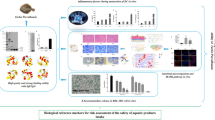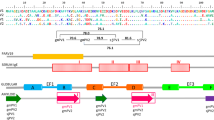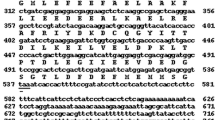Abstract
Fish parvalbumin is a major allergen known to cause allergy and has been a serious concern of food safety all over the world. Recombinant allergen has been broadly applied in allergy diagnosis and immunotherapy in recent years, but different immune activities of several recombinant allergens compared with their natural forms were found. To further characterize and explain the difference between natural and recombinant allergens, in this study, the difference of structure, Ca2+ binding, IgE/IgG binding activity, degranulation ability and digestion stability between natural and recombinant turbot parvalbumins were compared. Both recombinant and natural parvalbumins bind to specific immunoglobulin E from fish allergic patients and rabbit IgG antibody, whereas recombinant parvalbumin showed lower IgG binding activity in inhibition assays. Moreover, recombinant parvalbumin showed comparable ability with natural parvalbumin in Ku812 cells degranulation assay. Besides, intestinal digestion stability of recombinant parvalbumin was similar with natural form while gastric digestion stability was reduced. In addition, similar secondary structure change as well as different tertiary structure change between recombinant and natural parvalbumins due to heating, Ca2+ depletion and heating after Ca2+ depletion was characterized by spectra analysis. Different Ca2+ binding of two forms of parvalbumins was also found according to their different structural changes after Ca2+ depletion. These results revealed that recombinant turbot parvalbumin preserved fundamental immunological properties of its natural form while improper folding of tertiary led to its different Ca2+ binding, lower IgG binding activity and digestion stability.








Similar content being viewed by others
References
Davis CM, Gupta RS, Aktas ON, Diaz V, Kamath SD, Lopata AL (2020) Clinical management of seafood allergy. J Allergy Clin Immunol Pract 8(1):37–44. https://doi.org/10.1016/j.jaip.2019.10.019
Connett GJ, Connett GJ, Gerez I, Cabrera-Morales EA, Yuenyongviwat A, Ngamphaiboon J, Chatchatee P, Sangsupawanich P, Soh SE, Yap GC, Shek LPC, Lee BW (2012) A population-based study of fish allergy in the Philippines, Singapore and Thailand. Int Arch Allergy Immunol 159(4):384–390. https://doi.org/10.1159/000338940
Liu GM, Wang N, Cai QF, Li T, Sun LC, Su WJ, Cao MJ (2010) Purification and characterization of parvalbumins from silver carp (Hypophthalmichthy molitrix). J Sci Food Agric 90(6):1034–1040. https://doi.org/10.1002/jsfa.3913
Van Do T, Elsayed S, Florvaag E, Hordvik I, Endresen C (2005) Allergy to fish parvalbumins: studies on the cross-reactivity of allergens from 9 commonly consumed fish. J Allergy Clin Immunol 116(6):1314–1320. https://doi.org/10.1016/j.jaci.2005.07.033
Tong WS, Yuen AW, Wai CY, Leung NY, Chu KH, Leung PS (2018) Diagnosis of fish and shellfish allergies. J Asthma Allergy 11:247–260. https://doi.org/10.2147/JAA.S142476
Elsayed S, Aas K (1971) Characterization of a major allergen (cod): observations on effect of denaturation on the allergenic activity. J Allergy Clin Immunol 47(5):283–291. https://doi.org/10.1016/S0091-6749(71)80006-4
Aas K, Elsayed SM (1969) Characterization of a major allergen (cod): effect of enzymic hydrolysis on the allergenic activity. J Allergy 44(6):333–343. https://doi.org/10.1016/0021-8707(69)90025-2
Monaci L, Pilolli R, De Angelis E, Crespo JF, Novak N, Cabanillas B (2020) Food allergens: classification, molecular properties, characterization, and detection in food sources. Adv Food Nutr Res. https://doi.org/10.1016/bs.afnr.2020.03.001
Valenta R, Karaulov A, Niederberger V, Zhernov Y, Elisyutina O, Campana R, Focke-Tejkl M, Curin M, Namazova-Baranova L, Wang JY, Pawankar R, Khaitov M (2018) Allergen extracts for in vivo diagnosis and treatment of allergy: Is there a future? J Allergy Clin Immunol Pract 6(6):1845–1855. https://doi.org/10.1016/j.jaip.2018.08.032
Zimmer J, Bonertz A, Vieths S (2017) Quality requirements for allergen extracts and allergoids for allergen immunotherapy. Allergol Immunopathol (Madr) 45(Suppl 1):4–11. https://doi.org/10.1016/j.aller.2017.09.002
van Ree R (2007) Indoor allergens: relevance of major allergen measurements and standardization. J Allergy Clin Immunol 119(2):270–277. https://doi.org/10.1016/j.jaci.2006.10.033
Klueber J, Costa J, Randow S, Codreanu-Morel F, Verhoeckx K, Bindslev-Jensen C, Ollert M, Hoffmann-Sommergruber K, Morisset M, Holzhauser T, Kuehn A (2019) Homologous tropomyosins from vertebrate and invertebrate: recombinant calibrator proteins in functional biological assays for tropomyosin allergenicity assessment of novel animal foods. Clin Exp Allergy 50(1):105–116. https://doi.org/10.1111/cea.13503
Kollmann D, Geroldinger-Simic M, Kinaciyan T, Huber H, Ebner C, Lidholm J, Bohle B (2013) Recombinant Mal d 1 is a reliable diagnostic tool for birch pollen allergen–associated apple allergy. J Allergy Clin Immunol 132(4):1008–1010. https://doi.org/10.1016/j.jaci.2013.05.030
Hurlburt BK, McBride JK, Nesbit JB, Ruan S, Maleki SJ (2014) Purification of recombinant peanut allergen Ara h 1 and comparison of IgE binding to the natural protein. Foods 3(4):642–657. https://doi.org/10.3390/foods3040642
Himly M, Jahn-Schmid B, Dedic A, Kelemen P, Wopfner N, Altmann F, van Ree R, Briza P, Richter K, Ebner C, Ferreira F (2003) Art v 1, the major allergen of mugwort pollen, is a modular glycoprotein with a defensin-like and a hydroxyproline-rich domain. FASEB J 17(1):106–108. https://doi.org/10.1096/fj.02-0472fje
Sun L, Xu L, Huang Y, Lin H, Ahmed I, Li Z (2019) Identification and comparison of allergenicity of native and recombinant fish major allergen parvalbumins from Japanese flounder (Paralichthys olivaceus). Food Funct 10(10):6615–6623. https://doi.org/10.1039/c9fo01402k
Govindaraj D, Gaur SN, Arora N (2013) Characterization of recombinant per a 10 from Periplaneta americana. Clin Vaccine Immunol 20(2):262–268. https://doi.org/10.1128/CVI.00461-12
Costa J, Villa C, Verhoeckx K, Cirkovic-Velickovic T, Schrama D, Roncada P, Rodrigues PM, Piras C, Martín-Pedraza L, Monaci L, Molina E, Mazzucchelli G, Mafra I, Lupi R, Lozano-Ojalvo D, Larré C, Klueber J, Gelencser E, Bueno-Diaz C, Diaz-Perales A, Benedé S, Bavaro SL, Kuehn A, Hoffmann-Sommergruber K, Holzhauser T (2021) Are physicochemical properties shaping the allergenic potency of animal allergens? Clin Rev Allergy Immunol. https://doi.org/10.1007/s12016-020-08826-1
Reese G, Schicktanz S, Lauer I, Randow S, Lüttkopf D, Vogel L, Lehrer SB, Vieths S (2006) Structural, immunological and functional properties of natural recombinant Pen a 1, the major allergen of Brown Shrimp, Penaeus aztecus. Clin Exp Allergy 36(4):517–524. https://doi.org/10.1111/j.1365-2222.2006.02454.x
Lv L, Lin H, Li Z, Wang J, Ahmed I, Chen H (2017) Changes of structure and IgE binding capacity of shrimp (Metapenaeus ensis) tropomyosin followed by acrolein treatment. Food Funct 8(3):1028–1036. https://doi.org/10.1039/c6fo01479h
Ahmed I, Lin H, Xu L, Li S, Costa J, Mafra I, Chen G, Gao X, Li Z (2020) Immunomodulatory effect of laccase/caffeic acid and transglutaminase in alleviating shrimp tropomyosin (Met e 1) allergenicity. J Agric Food Chem 68(29):7765–7778. https://doi.org/10.1021/acs.jafc.0c02366
Ahmed I, Ma J, Li Z, Lin H, Xu L, Sun L, Tian S (2019) Effect of tyrosinase and caffeic acid crosslinking of turbot parvalbumin on the digestibility, and release of mediators and cytokines from activated RBL-2H3 cells. Food Chem 300:125209. https://doi.org/10.1016/j.foodchem.2019.125209
Brodkorb A, Egger L, Alminger M, Alvito P, Assuncao R, Ballance S, Bohn T, Bourlieu-Lacanal C, Boutrou R, Carriere F, Clemente A, Corredig M, Dupont D, Dufour C, Edwards C, Golding M, Karakaya S, Kirkhus B, Le Feunteun S, Lesmes U, Macierzanka A, Mackie AR, Martins C, Marze S, McClements DJ, Menard O, Minekus M, Portmann R, Santos CN, Souchon I, Singh RP, Vegarud GE, Wickham MSJ, Weitschies W, Recio I (2019) INFOGEST static in vitro simulation of gastrointestinal food digestion. Nat Protoc 14(4):991–1014. https://doi.org/10.1038/s41596-018-0119-1
Shi L, Xu H, Wu Y, Li X, Zou L, Gao J, Chen H (2017) α7-nicotinic acetylcholine receptors involve the imidacloprid-induced inhibition of IgE-mediated rat and human mast cell activation. RSC Adv 7(82):51896–51906. https://doi.org/10.1039/c7ra07862e
Willison LN, Sathe SK, Roux KH (2014) Production and analysis of recombinant tree nut allergens. Methods 66(1):34–43. https://doi.org/10.1016/j.ymeth.2013.07.033
Kobayashi A, Kobayashi Y, Shiomi K (2016) Fish allergy in patients with parvalbumin-specific immunoglobulin E depends on parvalbumin content rather than molecular differences in the protein among fish species. Biosci Biotechnol Biochem 80(10):2018–2021. https://doi.org/10.1080/09168451.2016.1189318
Vologzhannikova AA, Khorn PA, Kazakov AS, Permyakov EA, Uversky VN, Permyakov SE (2019) Effects of his-tags on physical properties of parvalbumins. Cell Calcium 77:1–7. https://doi.org/10.1016/j.ceca.2018.11.006
Ma Y, Griesmeier U, Susani M, Radauer C, Briza P, Erler A, Bublin M, Alessandri S, Himly M, Vazquez-Cortes S, de Arellano IR, Vassilopoulou E, Saxoni-Papageorgiou P, Knulst AC, Fernandez-Rivas M, Hoffmann-Sommergruber K, Breiteneder H (2008) Comparison of natural and recombinant forms of the major fish allergen parvalbumin from cod and carp. Mol Nutr Food Res 52(Suppl 2):S196-207. https://doi.org/10.1002/mnfr.200700284
Hamada Y, Tanaka H, Sato A, Ishizaki S, Nagashima Y, Shiomi K (2004) Expression and evaluation of IgE-binding capacity of recombinant Pacific mackerel parvalbumin. Allergol Int 53(3):271–278. https://doi.org/10.1111/j.1440-1592.2004.00344.x
Bugajska-Schretter A, Elfman L, Fuchs T, Kapiotis S, Rumpold H, Valenta R, Spitzauer S (1998) Parvalbumin, a cross-reactive fish allergen, contains IgE-binding epitopes sensitive to periodate treatment and Ca2+ depletion. J Allergy Clin Immunol 101(1):67–74. https://doi.org/10.1016/S0091-6749(98)70195-2
Biter AB, Pollet J, Chen WH, Strych U, Hotez PJ, Bottazzi ME (2019) A method to probe protein structure from UV absorbance spectra. Anal Biochem 587:113450. https://doi.org/10.1016/j.ab.2019.113450
Antosiewicz JM, Shugar D (2016) UV-Vis spectroscopy of tyrosine side-groups in studies of protein structure. Part 2: selected applications. Biophys Rev 8(2):163–177. https://doi.org/10.1007/s12551-016-0197-7
Xi X, Li X, Wu F, Guan X, Jin L, Guo Y, Song W, Du B (2017) Expression, purification and characterization of active untagged recombinant human leukemia inhibitory factor from E. coli. Protein Expr Purif 134:139–146. https://doi.org/10.1016/j.pep.2017.03.020
Kobayashi A, Ichimura A, Kobayashi Y, Shiomi K (2016) IgE-binding epitopes of various fish parvalbumins exist in a stereoscopic conformation maintained by Ca(2+) binding. Allergol Int 65(3):345–348. https://doi.org/10.1016/j.alit.2016.02.004
Mohammadi M, Mokhtarian K, Kardar GA, Farrokhi S, Sadroddiny E, Khorramizadeh MR, Falak R (2017) Expression of recombinant parvalbumin from wolf-herring fish and determination of its IgE-binding capability. Food Hydrocolloids 28(4):573–585. https://doi.org/10.1080/09540105.2017.1306493
Van Do T, Hordvik I, Endresen C, Elsayed S (2003) The major allergen (parvalbumin) of codfish is encoded by at least two isotypic genes: cDNA cloning, expression and antibody binding of the recombinant allergens. Mol Immunol 39(10):595–602. https://doi.org/10.1016/S0161-5890(02)00200-6
Xi J, He M, Pi J (2019) Identification of antigenic sites destructed by high hydrostatic pressure (HHP) of the beta subunit of beta-conglycinin. Int J Biol Macromol 141:1287–1292. https://doi.org/10.1016/j.ijbiomac.2019.09.042
Wickham M, Faulks R, Mills C (2009) In vitro digestion methods for assessing the effect of food structure on allergen breakdown. Mol Nutr Food Res 53(8):952–958. https://doi.org/10.1002/mnfr.200800193
Xu LL, Zhang HW, Zhang XM, Lin H, Guo YM, Yu C, Sun LR, Li ZX (2020) Natural Shrimp (Litopenaeus vannamei) tropomyosin shows higher allergic properties than recombinant ones as compared through SWATH-MS-based proteomics and immunological response. J Agric Food Chem 68(41):11553–11567. https://doi.org/10.1021/acs.jafc.0c03840
Toda M, Reese G, Gadermaier G, Schulten V, Lauer I, Egger M, Briza P, Randow S, Wolfheimer S, Kigongo V, Del Mar San Miguel Moncin M, Fotisch K, Bohle B, Vieths S, Scheurer S (2011) Protein unfolding strongly modulates the allergenicity and immunogenicity of Pru p 3, the major peach allergen. J Allergy Clin Immunol 128(5):1022–1030. https://doi.org/10.1016/j.jaci.2011.04.020
Acknowledgements
The authors would like to express their sincere thanks to the Fundamental Research Funds for National Natural Science Foundation of China (31871719) for supporting this study.
Author information
Authors and Affiliations
Corresponding author
Ethics declarations
Conflict of interest
The authors declare that they have no conflicts of interest.
Compliance with ethics requirements
All experiments performed in present study involving human serum were in accordance with the protocol approved by the local medical ethics committee (File no. QD-PF-20190618685) to fully protect the rights and interests of the human subjects.
Additional information
Publisher's Note
Springer Nature remains neutral with regard to jurisdictional claims in published maps and institutional affiliations.
Rights and permissions
About this article
Cite this article
Huang, Y., Li, Z., Wu, Y. et al. Comparison of immunological properties of recombinant and natural turbot (Scophthalmus maximus) parvalbumin. Eur Food Res Technol 247, 2053–2065 (2021). https://doi.org/10.1007/s00217-021-03771-5
Received:
Revised:
Accepted:
Published:
Issue Date:
DOI: https://doi.org/10.1007/s00217-021-03771-5




